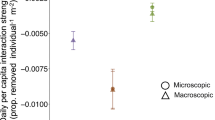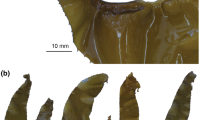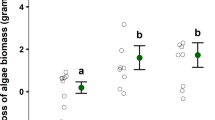Abstract
Herbivory can be an important factor structuring coastal algal communities. Herbivores may preferentially graze particular algal species or tissue types. Mesograzers, despite their small size, can critically weaken kelp thalli and impact entire kelp beds. We propose that when kelp beds are composed of several kelp cohorts, mesograzers will selectively choose to inhabit younger plants and grazing activities will have a greater impact on younger plants. This study investigated the effects of grazing by the littorinid gastropod, Lacuna vincta, on different age classes of the bull kelp, Nereocystis luetkeana by (1) testing food preference of L. vincta on juvenile, first-year adult, and second-year adult Nereocystis blades in the laboratory, (2) determining substrate (blades of different ages) preference of L. vincta in the laboratory, and by (3) estimating in-situ herbivore abundances and densities on juvenile and adult Nereocystis. Results demonstrated that grazing by L. vincta produced greater damage on juvenile than older Nereocystis tissues. Although L. vincta did not select juvenile versus older kelps as substrate in the laboratory, in situ surveys showed that differences existed between age classes with higher L. vincta densities on juvenile than adult kelp. We conclude that at a local scale, L. vincta can be an important structuring factor in Nereocystis populations due to its high density and grazing ability.





Similar content being viewed by others
References
Brawley, S. H., 1992. Mesoherbivores. In John D. M., S. J. Hawkins & J. H. Price (eds), Plant-Animal Interactions in the Marine Benthos. Clarendon Press, Oxford, 235–263.
Carney, L. T., J. R. Waaland, T. Klinger & K. Ewing, 2005. Restoration of the bull kelp Nereocystis luetkeana in nearshore rocky habitats. Marine Ecology Progress Series 302: 49–61.
Chavanich, S. & L. G. Harris, 2002. The influence of macroalgae on seasonal abundance and feeding preference of a subtidal snail, Lacuna vincta (Montagu) (Littorinidae) in the Gulf of Maine. Journal of Molluscan Studies 68: 73–78.
Chenelot, H., 2003. Factors affecting estuarine populations of Nereocystis luetkeana in Kachemak Bay, Alaska. M. Sc. Thesis. University of Alaska Fairbanks, Fairbanks, Alaska.
Dayton, P. K., 1985. Ecology of kelp communities. Annual Review of Ecology and Systematics 16: 215–245.
Denny, M. W., B. P. Gaylord & E. A. Cowen, 1997. Flow and Flexibility II. The roles of size and shape in determining wave forces on the bull kelp Nereocystis luetkeana. Journal of Experimental Biology 200: 3165–3183.
Duffy, J. E. & M. E. Hay, 1994. Herbivore resistance to seaweed chemical defense: the role of mobility and predation risk. Ecology 75: 1304–1319.
Duffy, J. E. & M. E. Hay, 2000. Strong impacts of grazing amphipods on the organization of a benthic community. Ecological Monographs 70: 237–263.
Duggins, D. O., 1980. Kelp beds and sea otters: an experimental approach. Ecology 61: 447–453.
Duggins, D. O., J. E. Eckman, C. E. Siddon & T. Klinger, 2001. Interactive roles of mesograzers and current flow in survival of kelps. Marine Ecology Progress Series 223: 143–155.
Estes, J. A., M. T. Tinker, T. M. Williams & D. F. Doak, 1998. Killer whale predation on sea otters linking oceanic and nearshore ecosystems. Science 282: 473–476.
Foreman, R. E., 1970. Physiology, ecology, and development of the brown alga Nereocystis luetkeana (Mertens) P. & R. Ph.D. Thesis. University of California, Berkley, California.
Foster, M. S. & D. R. Schiel, 1985. The ecology of giant kelp forests in California: a community profile. U. S. Fish and Wildlife Service Biological Report, Slidell, LA. Report 85 (7.2).
Fralick, R. A., K. W. Turgeon & A. C. Mathieson, 1974. Destruction of kelp populations by Lacuna vincta (Montagu). Nautilus 88: 112–114.
Fretter, V. & R. Manly, 1977. Algal associations of Tricolia pulus, Lacuna vincta and Cerithiopsis tubercularis (Gastropoda) with special reference to the settlement of their larvae. Journal of the Marine Biological Association of the United Kingdom 57: 999–1017.
Harris, L. G., A. W. Ebeling, D. R. Laur & R. J. Rowley, 1984. Community recovery after storm damage: a case of facilitation in primary succession. Science 224: 1336–1338.
Heaven, C. & R. Scrosati, 2004. Feeding preference of Littorina snails (Gastropoda) for bleached and photosynthetic tissues of seaweed Mazzaella parksii (Rhodophyta). Hydrobiologia 513: 239–243.
Iken, K. B., 1999. Feeding ecology of the Antarctic herbivorous gastropod Laevilacunaria antarctica Martens. Journal of Experimental Marine Biology and Ecology 236: 133–148.
Johnson, C. R. & K. H. Mann, 1986. The importance of plant defense abilities to the structure of subtidal seaweed communities: the kelp Laminaria longicruris de la Pylaie survives grazing by the snail Lacuna vincta (Montagu) at high population densities. Journal of Experimental Marine Biology and Ecology 97: 231–267.
Jones, L. G., 1971. Small herbivorous invertebrates of canopy and holdfast. Nova Hedwigia 32: 343–368.
Koehl, M. A. R. & S. A. Wainwright, 1977. Mechanical adaptations of a giant kelp. Limnology and Oceanography 22: 1067–1071.
Leighton, D. L., 1971. Grazing activities of benthic invertebrates in kelp beds. Nova Hedwigia 32: 421–454.
Leonard, G. H., 1994. Effect of the bat star Asterina miniata (Brandt) on recruitment of the giant kelp Macrocystis pyrifera C. Agardh. Journal of Experimental Marine Biology and Ecology 179: 81–98.
Lubchenco, J. & S. D. Gaines, 1981. A unified approach to marine plant-herbivore interactions. 1. Populations and communities. Annual Review of Ecology and Systematics 12: 405–437.
Mann, K. H. & P. A. Breen, 1972. The relation between lobster abundance, sea urchins, and kelp beds. Journal of Fisheries Research Board of Canada 29: 603–609.
Martel, A. & F. S. Chia, 1991a. Oviposition, larval abundance, in situ larval growth and recruitment of the herbivorous gastropod Lacuna vincta in kelp canopies in Barkley Sound, Vancouver Island (British Columbia). Marine Biology 110: 237–247.
Martel, A. & F. S. Chia, 1991b. Foot-raising behaviour and active participation during the initial phase of post-metamorphic drifting in the gastropod Lacuna spp. Marine Ecology Progress Series 72: 247–254.
Martel, A. & T. Diefenbach, 1993. Effects of body size, water current and microhabitat on mucous-thread drifting in post-metamorphic gastropods Lacuna spp. Marine Ecology Progress Series 99: 215–220.
Maxell, B. A. & K. A. Miller, 1996. Demographic studies of the annual kelps Nereocystis luetkeana and Costaria costata (Laminariales, Phaeophyta) in Puget Sound, Washington. Botanica Marina 39: 479–489.
Morris, T. J. & A. Campbell, 1996. Growth of juvenile red sea urchins (Strongylocentrotus franciscanus) fed Zostera marina or Nereocystis luetkeana. Journal of Shellfish Research 15: 777–780.
North, W. J. (ed.), 1971. The biology of giant kelp beds (Macrocystis) in California. J. Cramer, Lehre Germany.
North, W. J., 1979. Adverse factors affecting giant kelp and associated seaweeds. Experientia 35: 445–447.
Norton, T. A. & M. R. Benson, 1983. Ecological interactions between the brown seaweed Sargassum muticum and its associated fauna. Marine Biology 75: 169–177.
Norton, T. A., S. J. Hawkins, N. L. Manley, G. A. Williams & D. C. Watson, 1990. Scraping a living: a review of littorinid grazing. Hydrobiologia 193: 117–138.
O’Clair, R. M. & S. C. Lindstrom, 2000. North Pacific seaweeds. Plant Press, Auke Bay, Alaska.
Padilla, D. K., 1985. Structural resistance of algae to herbivores: a biomechanical approach. Marine Biology 90: 103–109.
Padilla, D. K., 1993. Rip stop in marine algae: minimizing the consequences of herbivore damage. Evolutionary Ecology 7: 634–644.
Padilla, D. K., 1998. Inducible phenotypic plasticity of the radula in Lacuna (Gastropoda: Littorinidae). Veliger 41: 201–204.
Padilla, D. K., 2001. Food and environmental cues trigger an inducible offence. Evolutionary Ecology Research 3: 15–25.
Pelletreau, K. N. & G. Muller-Parker, 2002. Sulfuric acid in the phaeophyte alga Desmarestia munda deters feeding by the sea urchin Strongylocentrotus droebachiensis. Marine Biology 141: 1–9.
SAS Institute Inc., 1999. SAS/STAT User’s guide, Version 8. SAS Institute Inc., Cary, NC.
Smith, D. A. S., 1973. The population biology of Lacuna pallidula (da Costa) and Lacuna vincta (Montagu) in north-east England. Journal of the Marine Biological Association of the United Kingdom 53: 493–520.
StatView, 1999. Third edition. SAS Institute Inc., Cary, NC.
Steinberg, P. D., 1984. Algal chemical defense against herbivores: allocation of phenolic compounds in the kelp Alaria marginata. Science 223: 405–406.
Steinberg, P. D., 1985. Feeding preferences of Tegula funebralis and chemical defenses of marine brown algae. Ecological Monographs 55: 333–349.
Steneck, R. S. & L. Watling, 1982. Feeding capabilities and limitation of herbivorous molluscs: a functional group approach. Marine Biology 68: 299–319.
Taylor, R. B., 1998. Density, biomass and productivity of animals in four subtidal rocky reef habitats: the importance of small mobile invertebrates. Marine Ecology Progress Series 172: 37–51.
Taylor, R. B., E. Sotka & M. E. Hay, 2002. Tissue-specific induction of herbivore resistance: seaweed response to amphipod grazing. Oecologia 132: 68–76.
Tegner, M. J. & P. K. Dayton, 1987. El Niño effects on southern California kelp forest communities. Advances in Ecological Research 17: 243–279.
Thomas, M. L. H. & F. H. Page, 1983. Grazing by the gastropod, Lacuna vincta, in the lower intertidal area at Musquash Head, New Brunswick, Canada. Journal of the Marine Biological Association of the United Kingdom 63: 725–736.
Toth, G. B. & H. Pavia, 2002a. Intraplant habitat and feeding preference of two gastropod herbivores inhabiting the kelp Laminaria hyperborea. Journal of the Marine Biological Association of the United Kingdom 82: 243–247.
Toth, G. B. & H. Pavia, 2002b. Lack of phlorotannin induction in the kelp Laminaria hyperborea in response to grazing by two gastropod herbivores. Marine Biology 140: 403–409.
Vadas, R. L., 1985. Herbivory. In Littler, M. M. & D. S. Littler (eds), Handbook of Phycological Methods. Ecological Field Methods: Macroalgae. Cambridge University Press, Cambridge, 532–572.
Van Alstyne, K. L., J. M. Ehlig & S. L. Whitman, 1999. Feeding preferences for juvenile and adult algae depend on algal stage and herbivore species. Marine Ecology Progress Series 180: 179–185.
Van Alstyne, K. L., S. L. Whitman & J. M. Ehlig, 2001. Differences in herbivore preferences, phlorotannin production, and nutritional quality between juvenile and adult tissues from marine brown algae. Marine Biology 139: 201–210.
Watson, D. C. & T. A. Norton, 1985a. Dietary preferences of the common periwinkle, Littorina littorea (L.). Journal of Experimental Marine Biology and Ecology 88: 193–211.
Watson, D. C. & T. A. Norton, 1985b. The physical characteristics of seaweed thalli as deterrents of Littorine grazers. Botanica Marina 28: 383–387.
Williams, G. A., 1990. Littorina mariae – a factor structuring low shore communities? Hydrobiologia 193: 139–146.
Winter, F. & J. A. Estes, 1992. Experimental evidence for the effects of polyphenolic compounds from Dictyoneurum californicum Ruprecht (Phaeophyta: Laminariales) on feeding rate and growth in the red abalone Haliotus rufescens Swainson. Journal of Experimental Marine Biology and Ecology 155: 263–277.
Acknowledgements
This study was supported by the West Coast & Polar Regions Undersea Research Center (Global Undersea Research Unit). We thank Casey Debenham for his help as a dive buddy and the Kasitsna Bay Laboratory for their logistical support. We are grateful to Drs. Katrin Iken and Nora Foster for their precious comments on an earlier version of the manuscript and to the Kachemak Bay Research Reserve for their unfailing enthusiasm. We also greatly appreciate the valuable comments and constructive criticism from three anonymous reviewers.
Author information
Authors and Affiliations
Corresponding author
Additional information
Handling editor: K. Martens
Rights and permissions
About this article
Cite this article
Chenelot, H., Konar, B. Lacuna vincta (Mollusca, Neotaenioglossa) herbivory on juvenile and adult Nereocystis luetkeana (Heterokontophyta, Laminariales). Hydrobiologia 583, 107–118 (2007). https://doi.org/10.1007/s10750-006-0484-6
Received:
Revised:
Accepted:
Published:
Issue Date:
DOI: https://doi.org/10.1007/s10750-006-0484-6




